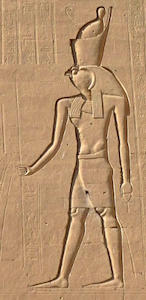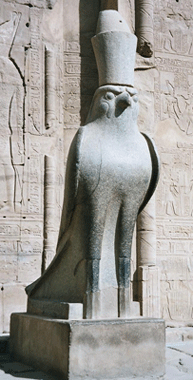The name Horus is Greek. In Ancient Egypt he was known as “Heru” (sometimes Hor or Har), which is translated as “the distant one” or “the one on high” (from the preposition “hr” meaning “upon” or “above”). He was considered to be a celestial falcon, and so his name could be a specific reference to the flight of the falcon, but could also be seen as a more general solar reference. It is thought that the worship of Horus was brought into Egypt during the predynastic period.

Horus seems to have begun as a god of war and a sky god who was married to Hathor, but soon became considered as the opponent of Set, the son of Ra, and later the son of Osiris. However, the situation is confused by the fact that there were many Hawk gods in ancient Egypt and a number of them shared the name Horus (or more specifically Har, Heru or Hor). Furthermore, the gods Ra, Montu and Sokar could all take the form of a falcon. Each “Horus” had his own cult center and mythology, but over time they merged and were absorbed by the most popular Horus, Horus Behedet (Horus of Edfu).
Horus was the protector and patron of the pharaoh. As Horus was associated with Upper Egypt (as Heru-ur in Nekhen) and Lower Egypt (as Horus Behedet or Horus of Edfu) he was the perfect choice for a unified country and it seems that he was considered to be the royal god even before unification took place. The Pharaoh was often considered to be the embodiment of Horus while alive (and Osiris once he was deceased). The Turin Canon, describes the Predynastic rulers of Egypt as “the Followers of Horus”, and the majority of Pharaohs had an image of Horus at the top of their serekh (a stylised palace facade in which one of the king’s names was written).

However, Sekhemhib (Seth Peribsen) chose to place Horus’ opposite and enemy Set on his serekh while Khasekhemwy placed both Set and Horus above his serekh. As a result, some scholars argue that the mythical battle between Horus and Set was once a real battle between the followers of Set and the followers of Horus. If this was the case, it would seem that the followers of Horus won as Horus remained a popular emblem of kingship while Set was gradually transformed into a symbol of evil. The Pharaoh also had a name (known as the “Golden Horus” name) which was preceded by an image of a sacred hawk on the symbol for gold which specifically linked the Pharaoh to the god. However, it is interesting to note that Set was also known as he of Nubt (gold town), so the symbol for gold could in fact relate to him.
Horus and Set were always placed in opposition to each other. However, the exact nature of their relationship changed somewhat over time. Set was the embodiment of disorder and chaos while Horus was the embodiment of order. Similarly, Horus represented the daytime sky while Set represented the night time sky. However, in early times the two were also seen as existing in a state of balance in which Horus and Set represented Upper and Lower Egypt respectively. They were often depicted together to indicate the union of Upper and Lower Egypt and there is even a composite deity named Horus-Set, who was depicted as a man with two heads (one of the hawk of Horus, the other of the Set animal).

At this stage Horus was often considered to be Set’s brother and equal, and the fight between them was thought to be eternal. However, the rise in importance of the Ennead resulted in Horus being cast as the son of Osiris and thus the nephew of Set. This changed the nature of the conflict between them, as it was now possible for Set to be defeated and for Horus to claim the throne of Egypt as his own.
The “Eye of Horus” was a powerful protective amulet and when it was broken into pieces (in reference to the time Set ripped out Horus’ eye), the pieces were used to represent the six senses (including thought) and a series of fractions.
Horus was also the patron of young men and was often described as the perfect example of the dutiful son who grows up to become a just man. However, this is perhaps debatable in the light of one of the stories concerning his fight with Set. The mother of Horus (Isis) was a great magician who most certainly had the power to destroy Set. However, when her chance came she could not take it. Set was, after all, her brother. This angered Horus so much that he chopped off his mother’s head in a fit of rage! Thankfully, Isis was more than able to handle this insult and immediately caused a cow’s head to grow from her neck to replace her head. Luckily for Horus, Isis was a compassionate and sympathetic goddess and she forgave her vengeful son his aggressive act.
The Egyptian God Horus was usually depicted as a falcon, or a falcon-headed man. He often wore the Double Crown of Upper and Lower Egypt. In anthropomorphic form Horus appears as both an adult man and a child, wearing the sidelock of youth (as the son of Isis). There are also numerous depictions of a Horus the child hunting crocodiles and serpents and amulets known as “cippi” were inscribed with his image to ward off dangerous animals.
- Heru-ur (Horus the elder)
- Khenty-Khem (foremost of Khem, Khenty-irty, Menkhenty-irty)
- Horus of Behedet (Horus of Edfu)
- Heru-sa-Aset (Horus the child of Isis)
- Horemakhet (Horus in the horizons)
- Horakhty (Horus of the two horizons)
Bibliography
- Bard, Kathryn (2008) An introduction to the Archaeology of Ancient Egypt
- Goodenough, Simon (1997) Egyptian Mythology
- Grajetzki, W (2003) Burial Customs in Ancient Egypt
- Kemp, Barry J (1991) Ancient Egypt: Anatomy of a Civilisation
- Redford Donald B (2002) Ancient Gods Speak
- Watterson, Barbara (1996) Gods of Ancient Egypt
- Wilkinson, Richard H. (2003) The Complete Gods and Goddesses of Ancient Egypt
- Wilkinson, Richard H. (2000) The Complete Temples of Ancient Egypt
Copyright J Hill 2008